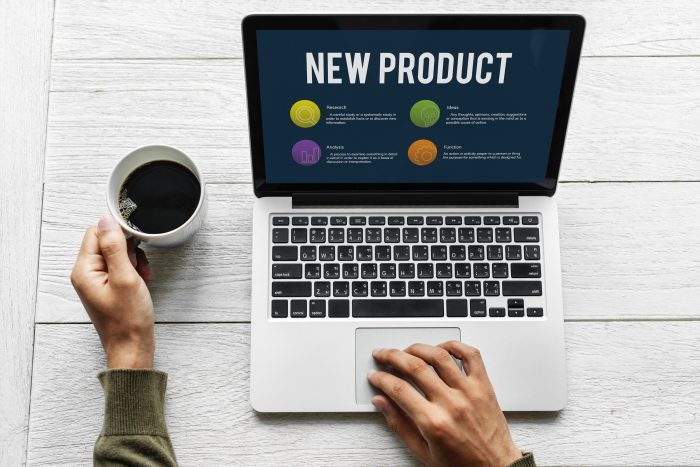
Source: https://www.pexels.com/photo/person-holding-mug-beside-turned-on-macbook-1549702/
When it is all about building a great product, ‘product design’ is something which matters the most. We are currently at a stage where product design is dominating the business scenario. It is something which is setting the companies apart.
A few years back, the term was only applicable to building physical products. But now, when we talk about product design, we mean building digital products too. For instance, websites and apps are modern digital products which form the core of any business.
What Is Product Design All About?
Product design mainly involves the process of identification of any specific market opportunity, defining a particular problem and coming up with a proper solution. The last stage of product designing involves validating the solution with real users.
Whether you are an entrepreneur or a designer, it is very important for you to understand the basics of product design.
Here’s Some Of The Quintessential Product Design Guidelines:
1. Keep Your Product Design Simple
Creating your product design does not mean that you have to make your design look fully ornamented. Remember, too much ornamentation confuses the users. Better if you keep it simple and lean. Stuffing your products with too many features reduces the UX quality.
Your job is not to complicate your user’s product journey, but to provide a solution with the design. Your users will never notice your product design, but they will see if it’s solving their pain points.
Users look for irreducible simplicity in your products.
If you are now thinking that you have a complex product and need to simplify it, then go for simplifying just a few of the features, which you think is essential to change. Remember, you are not supposed to change the entire product, but some of its features. So, be very cautious while you make the changes.
In this way, the product’s final structure will remain simple.
2. Product Design Should Be Highly Intuitive
There is a tremendous level of competition between Android and Apple’s products. Both brands have created their own distinguishable products. While Android allows its users to go for full software customization, Apple completely takes control of the user’s experience. It has set up a few standards and parameters that have reduced the flexibility of using Apple products.
Both Google and Apple are of the view that they have created intuitive products. However, the market share between the two giants is strikingly different. Although Android has been more popular, Apple’s share of profit is more in the smartphone market as people are willing to pay more for it.
So, the fact here is what seems intuitive to me, may not seem intuitive to others.
Therefore, while you build your product design, design it intuitively by empathizing with your target customers. You can analyze your product against the intuition principle by asking yourself questions like:
How long will it take for someone to completely understand my product design?
What are the ways through which my product design can be improved?
Is my product providing any solution?
Hopefully, after finding out the answers you will be able to analyze if your product design is actually intuitive or not.
3. Your Product Design Should Show It’s Value
Your users are never going to realize the worth of your product until and unless they see the hidden value of it. Your product design should showcase or reflect that.
For this, you need to design the product in such a way so that the customer could directly relate to their problem and see an underlying solution in your product.
To assess your product against the principle of beauty underneath, ask yourself questions like:
Is my product actually useful?
Is there any hidden value underlying in my product?
4. Your Product Design Should Address An Approachable Innovation
What’s the use of spending a fortune on some product design which is undecipherable by the audience?
Well, there are lots of examples of some famous brands, whose product design idea failed badly. Either they failed to follow the principles of product design, or they simply didn’t bother to validate their idea.
That is the reason why it becomes so important to go for an approachable innovation that is understandable and explicable to your customers or users.
There are several examples of companies whose product design idea failed. Some of them include PalmPilot, and Loudcloud.
Analyze your product against the approachable innovation principle by asking these questions:
In what ways your product is different from others?
When you are telling others about it, are they understanding it?
Are the customers familiar with some aspects of your product?
5. Your Product Design Should Conform With Form And Color
It is very critical that your product agrees with the form and color pattern. Any kind of product, should have a proper color and form for representing a specific purpose.
For instance, the iPhone, with it’s every launch has changed its form and color pattern. For instance, the recent changes that have been made by the iPhone makers include changes in its screen size and color variation.
If you are unsure about your product’s form and color agreement, then ask yourself these questions:
Have you done your research well on the type of color that you have chosen for your product design?
What do the lines, curves, angles, textures, and dimensions say about the product?
Do the form and color agree with the purpose of your product?
What’s Next?
One of the most crucial things to remember while you design your products is – you need to design for your users. Focusing on the proper solution and delivering the right features, is something that you should always keep in mind before you progress. What you need to do is to find the right mobile app development company who can guide you all the way to product designing.



